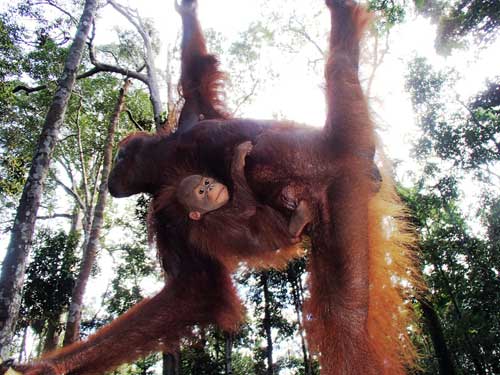AS naturally as the creeping vines coiled round the branches, the sure hands and feet of an agile ape grapped the rope dangling across a cluster of trees.

HOT MAMA: Delima, balancing with one arm from a tree branch above the feeding station.
The primate swung effortlessly to a feeding platform, landing softly on outstretched planks to pick up some fruits, then doubled back up the rope with both arms and one foot while taking a bite of the fruits held by the free foot.
The shy ape knew it was being watched but acted in such a way that suggested it wanted the on-lookers to understand how it lives in its natural habitat.
It was chow time at the feeding station of the Semenggoh Wildlife Sanctuary, home of the Borneoan orang utan (pongo pygmaeus), a species of distinct red coloured apes found only in this part of the world.
Situated slightly over one km inside the Semenggoh Orang Utan Rehabilitation Centre, the Sanctuary offers first-time visitors a very close encounter with these great apes during feeding time.

UNIQUE EXPERIENCE: American couple Roger (left) and Denise were among the many tourists who visited the Semenggoh Wildlife Centre.

WITH KIWI FRIENDS: Heng (right) and daughter Cass (second right) with the Chaplins from New Zealand.
The orang utans are one of the most distinct primates roaming the jungles of Borneo. Their exact population in the wild is not known other than that the species is listed as endangered.
thesundaypost learned that the threats facing the orange utans include poaching, habitat destruction and trading in exotic pets.
According to a staff of the Sarawak Forestry Corporation (SFC) which manages the Semenggoh Orang Utan Rehabilitation Centre, the survival of the primates is very important to the ecology of the area and people should be more concerned that these apes may be in a critical stage of their existence.

MOTHER AND INFANT: Minah with her baby Jubilee.
The Semenggoh Wildlife Sanctuary is one of the conservation centres where orang utans can live in their natural habitat and where people can also be educated on the primates and the threats they face.
There are now 27 orang utans born in captivity and have made the Sanctuary home.
A latest addition is a baby orang utan called Jubilee — meaning celebration.
It was given the name in conjunction with the Sarawak Golden Jubilee Celebration this year. Its birth also coincided with SFC’s 10th anniversary.
The few weeks old baby orang utan is the fourth successful delivery by 25-year-old Minah which was brought to the Sanctuary from Lubok Antu, Sri Aman, in 1993.
The SFC staff said orang utan offspring were dependent on their mothers until they were at least five years old, adding that adult males would have no contact with the infants.
Even though food is provided at the Sanctuary everyday, the orang utans learn to be independent by roaming the 1,613-acre nature reserve and learning to survive on their own.
“During the fruiting season, the apes are hardly seen — which is a good sign as it means they have the natural instinct to know there is plenty of food in the wild — not just at the feeding station,” the SFC staff explained.
An American couple who visited the Centre for the first time, said it was amazing to see the primates living so close to Nature within the Sanctuary.
“I have seen orang utans in zoos but watching them roaming freely in a natural habitat within the Sanctuary is breathtaking,” said Denise Sifee from Pennsylvania, USA.
Her partner Roger Brubaker was thrilled to see the apes feeding unfazed in the presence of visitors.
Brubaker said both he and Denise live in Thailand and are, thus, quite familiar with Southeast Asian flora and fauna.
A Kuching resident, known as Heng, and his daughter Cass, brought their friends, the Chaplin family — Elaine, Tim, and Mathew — from New Zealand to have a close look at the orang utans.
Heng said SFC had done a good job taking care of the primates and sharing with the rest of the world the extraordinary existence of these rare and intelligent apes.
“It’s a good setting here. People can get to know more about the orang utans and help preserve them.”
He added that they were a little disappointed for not getting a glimpse of baby Jubilee.
“Maybe the early tropical shower deterred them (Minah and Jubilee) from coming out from their morning rest.”
The other attraction at the Sanctuary is the alpha male, 31-year-old Ritchie, who could be the father of baby Jubilee.
“There is a possibility Ritchie is the father but we need to confirm its DNA as there are a few more male adults at the Sanctuary,” another SFC staff said.
One other primate attraction is a red-haired female called Delima, dubbed Hot Mama of Semenggoh.
Delima’s ‘glamorous’ and unique look comes from the short fringe above her forehead which has made her the poster girl of the Centre.
“She can be seen at one of the feeding stations and is not camera-shy,” the SFC staff added.
SFC welcomes those interested in the wildlife programme at the Sanctuary to volunteer their services.
The Centre appreciates the extra hands and expertise from those interested in the Orang Utan Adoption Programme.
The Centre is also a must-visit for visitors to Kuching city as it is one of the best wildlife attractions here.
The Sanctuary itself offers the opportunity to watch semi-wild orang utans in their natural environment.
Semenggoh became the first forest reserve in Sarawak in 1920.
It was turned into a wild life rehabilitation centre for monkeys, orang utans, honey bears and hornbills in 1975.

APES WATCHING: Visitors watching orang utans at the one of the feeding stations. — Photos courtesy of Sarawak Forestry Corporation.
